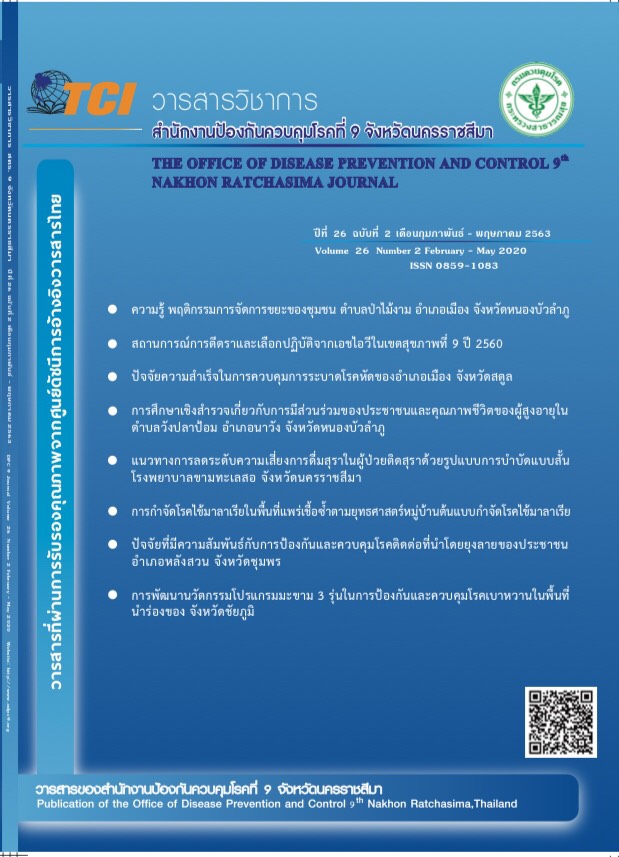Factors in Successful Control of Measles Outbreak in Mueang District, Satun Province
Keywords:
Factors of successful, Measles outbreak, CIPP model, Evaluation researchAbstract
This evaluation research purposed to study contexts, inputs, processes, and outputs, and to study successful factors for controlling measles outbreak in Mueang district, Satun province. The population of the study included administrators, health officers, environmental health persons, and persons of local administrative organizations in the areas where measles patients were detected about 36 cases. Measurement of the study included a checklist, an evaluation form, and an interview form by an in-depth interview; the Cronbach’s alpha coefficients of the evaluation form, especially the contexts, inputs, processes, and outcomes were 0.74, 0.92, 0.93, and 0.83 respectively. Quantitative data were analyzed by descriptive statistics such as frequency, percentage, mean, and standard deviation. Qualitative data were analyzed by using content analysis. The results indicated that contexts, inputs, processes, and outcomes for controlling measles outbreak were good level. Successful factors of the outbreak control in Mueang district, Satun province included a clearly established operation team. Situation analysis and trends to disease occurring were conducted to plan the guideline. It was approved by a relevant executive, immunization operation and coverage of vaccination were focused to be a target, rapid surveillance, collected specimen and sent to laboratory examination completely, rapid reporting system, adequate personnel with readiness for disease investigation and control, and also vaccines, materials/equipment, information technology was adequate and readiness. There were a good communication system and a coordinated network with community or people’s participation at the local level.
Keywords: Successful factors, Measles outbreak, CIPP model, Evaluation research
References
2.ปิยนิตย์ ธรรมาภรณ์พิลาศ, และเลิศฤทธิ์ ลีลาธร. (2559). แนวทางการเฝ้าระวังควบคุมโรค การตรวจรักษา และส่งตัวอย่างตรวจทางห้องปฏิบัติการเพื่อการกำจัดโรคหัดตามโครงการกำจัดโรคหัดตามพันธะสัญญา นานาชาติ. พิมพ์ครั้งที่ 3. กรุงเทพมหานคร: สำนักพิมพ์อักษรกราฟฟิคแอนด์ดีไซน์.
3. สำนักระบาดวิทยา กรมควบคุมโรค. (2561). รายงานโรคในระบบเฝ้าระวัง 506. สืบค้นจาก http://www.boe.moph.go.th. (วันที่สืบค้น 22 เมษายน 2562)
4. กลุ่มระบาดและข่าวกรอง สำนักงานป้องกันและควบคุมโรคที่ 12 จังหวัดสงขลา (2562). สถานการณ์โรคหัด.
5. งานระบาดวิทยา สำนักงานสาธารณสุขจังหวัดสตูล. (2562). รายงานโรคติดต่อที่ต้องเฝ้าระวังทางระบาดวิทยา.
6. งานระบาดวิทยาและควบคุมโรค โรงพยาบาลสตูล. (2562). สถานการณ์ผู้ป่วยโรคหัด.
7. ปนัดดา ไชยชมพู, และธันวดี รู้รอบ. (2558). โครงการพัฒนาต้นแบบอำเภอควบคุมโรคเข้มแข็งแบบยั่งยืนในพื้นที่สาธารณสุขเขต 14 ปี 2555. วารสารสคร.5 ปี 2555, 19(1), 5-17.
8. อุดม อัศวุตมางกุร, อารยา ประเสริฐชัย, และช่อทิพย์ บรมธนะรัตน์. (2560). การประเมินผลการดำเนินงานคุ้มครองผู้บริโภคด้านผลิตภัณฑ์สุขภาพในโรงพยาบาลส่งเสริมสุขภาพตำบล จังหวัดปทุมธานี. วารสารศูนย์การศึกษาแพทยศาสตร์คลินิก โรงพยาบาลพระปกเกล้า, 34(2),124-134.
9. ธีระวุธ ธรรมกุล, ไพโรจน์ พรหมพันใจ, บัณฑิต วรรณประพันธ์, และทิยรัตน์ สิงห์ทอง. (2555). การประเมินโครงการพัฒนาศักยภาพและกลไกการพยากรณ์โรคในพื้นที่สาธารณสุขเขต 14 ตามนโยบายหลัก กรมควบคุมโรค พ.ศ.2554. วารสารสคร.5 ปี 2555, 18(1), 45-57.
10. วรวิทย์ ตันติวัฒนทรัพย์, สุพาภรณ์ สุยะสืบ, และอนุพงษ์ อนุเมธางกูร. (2550). การระบาดของโรคหัดในอำเภออุ้งผาง จังหวัดตาก 2547 - 2548. สืบค้นจาก http://www.kb.hsri.or.th. (วันที่สืบค้น 15 เมษายน 2562)

Downloads
Published
How to Cite
Issue
Section
License
บทความที่ลงพิมพ์ในวารสารวิชาการสำนักงานป้องกันควบคุมโรคที่ 9 จังหวัดนครราชสีมา ถือว่าเป็น
ลิขสิทธิ์ สำนักงานป้องกันควบคุมโรคที่ 9 จังหวัดนครราชสีมา



